Age Discrimination's Impact on Employee Motivation: A Waitrose Study
VerifiedAdded on 2023/01/12
|8
|2538
|87
Report
AI Summary
This research project investigates the impact of age discrimination on employee motivation, focusing on a case study of Waitrose, a British supermarket. The introduction highlights workplace discrimination as a significant issue affecting employee motivation globally and emphasizes the importance of promoting equality. The research aims to analyze the reasons behind age discrimination, identify its impact on employee motivation, and explore ways to eliminate ageism in the workplace. The literature review covers the causes of age discrimination, its effects on motivation, and potential solutions such as providing fair opportunities, training, and fair promotion practices. The research methodology section outlines the use of a quantitative approach, a deductive method, and primary data collection through questionnaires. The expected outcomes suggest that addressing age discrimination can improve employee performance and establish a competitive image for the company. The report concludes with a list of references, including books and journals related to the research topic.

Research project proposal
Paraphrase This Document
Need a fresh take? Get an instant paraphrase of this document with our AI Paraphraser
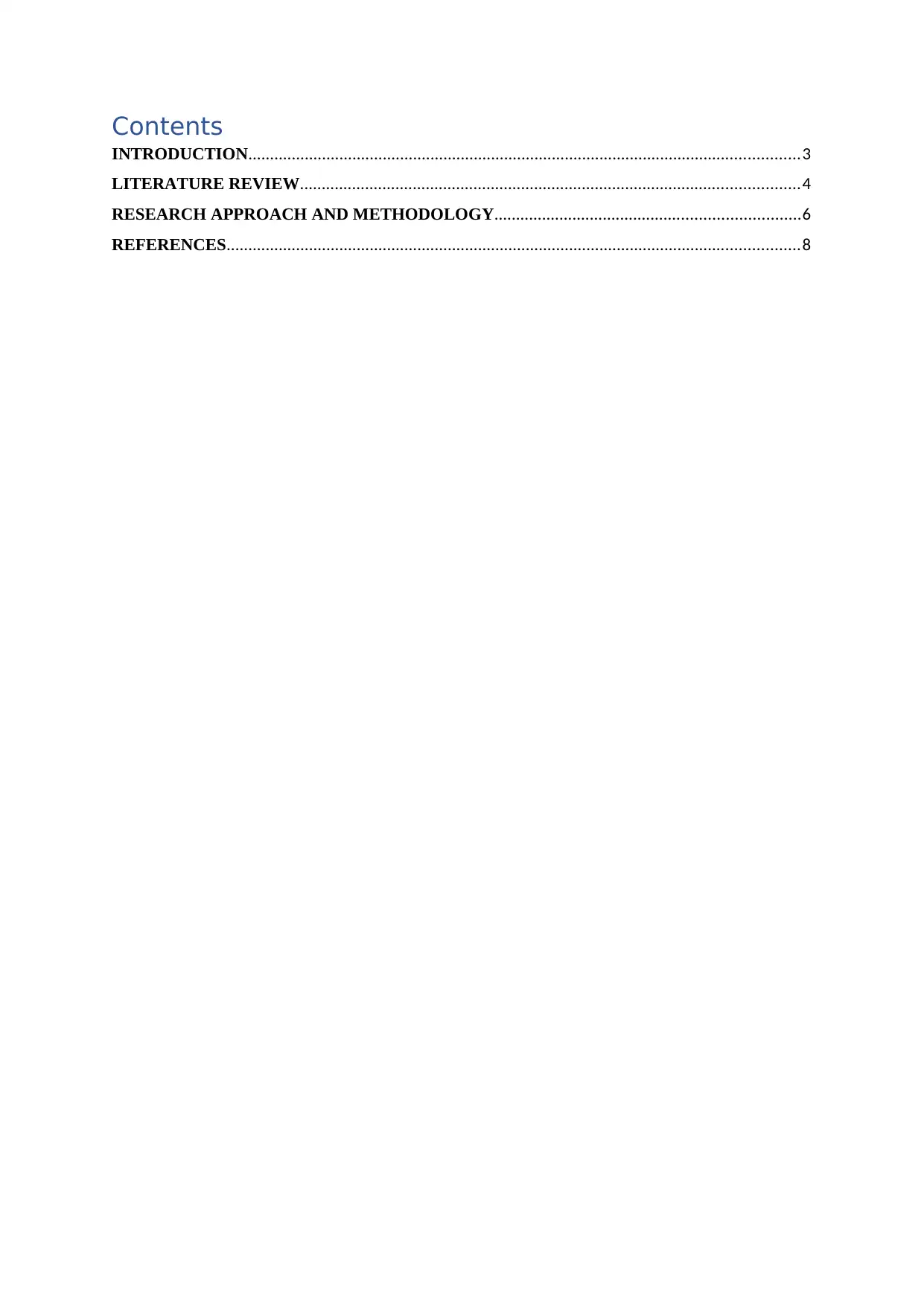
Contents
INTRODUCTION...............................................................................................................................3
LITERATURE REVIEW...................................................................................................................4
RESEARCH APPROACH AND METHODOLOGY......................................................................6
REFERENCES....................................................................................................................................8
INTRODUCTION...............................................................................................................................3
LITERATURE REVIEW...................................................................................................................4
RESEARCH APPROACH AND METHODOLOGY......................................................................6
REFERENCES....................................................................................................................................8
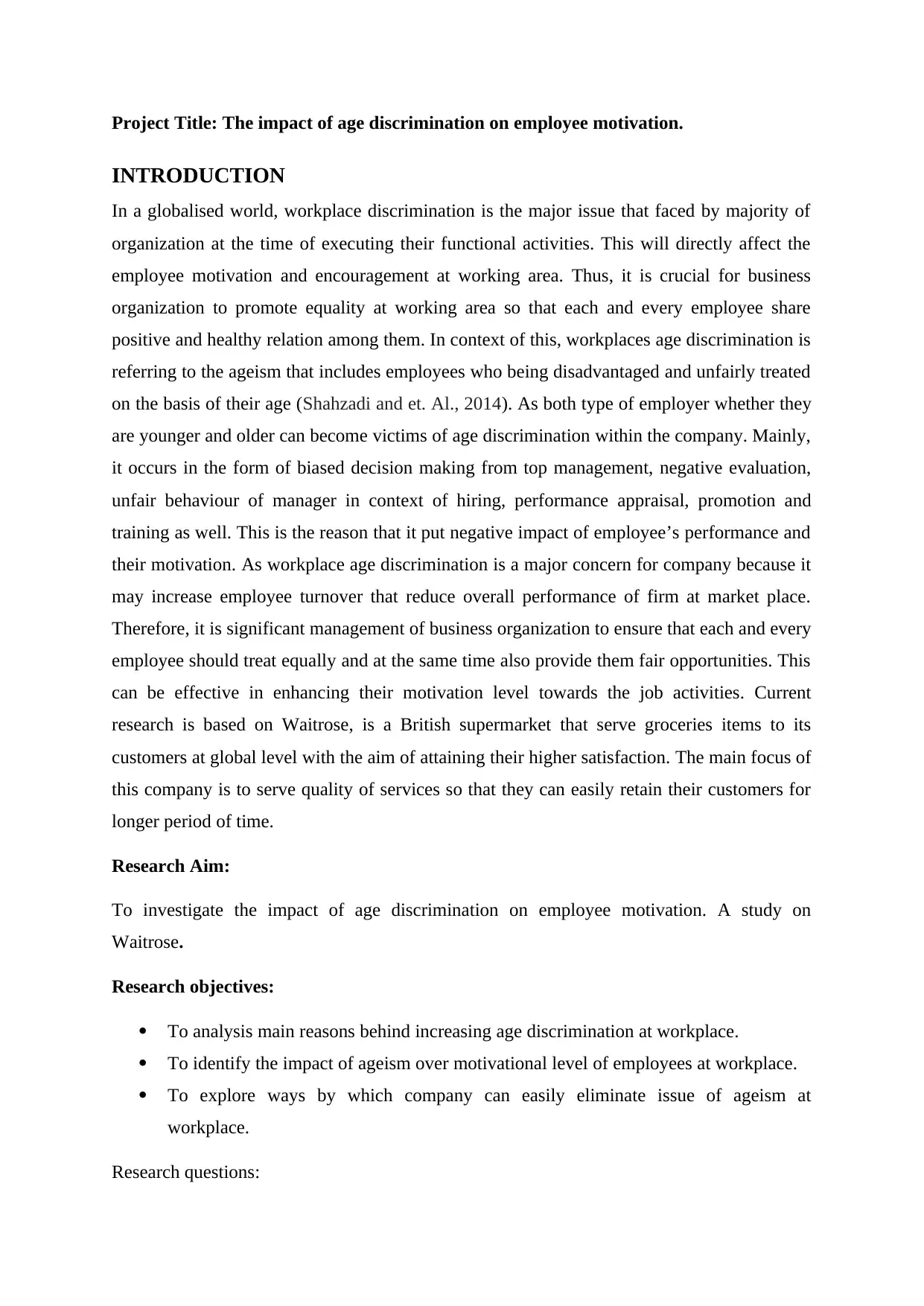
Project Title: The impact of age discrimination on employee motivation.
INTRODUCTION
In a globalised world, workplace discrimination is the major issue that faced by majority of
organization at the time of executing their functional activities. This will directly affect the
employee motivation and encouragement at working area. Thus, it is crucial for business
organization to promote equality at working area so that each and every employee share
positive and healthy relation among them. In context of this, workplaces age discrimination is
referring to the ageism that includes employees who being disadvantaged and unfairly treated
on the basis of their age (Shahzadi and et. Al., 2014). As both type of employer whether they
are younger and older can become victims of age discrimination within the company. Mainly,
it occurs in the form of biased decision making from top management, negative evaluation,
unfair behaviour of manager in context of hiring, performance appraisal, promotion and
training as well. This is the reason that it put negative impact of employee’s performance and
their motivation. As workplace age discrimination is a major concern for company because it
may increase employee turnover that reduce overall performance of firm at market place.
Therefore, it is significant management of business organization to ensure that each and every
employee should treat equally and at the same time also provide them fair opportunities. This
can be effective in enhancing their motivation level towards the job activities. Current
research is based on Waitrose, is a British supermarket that serve groceries items to its
customers at global level with the aim of attaining their higher satisfaction. The main focus of
this company is to serve quality of services so that they can easily retain their customers for
longer period of time.
Research Aim:
To investigate the impact of age discrimination on employee motivation. A study on
Waitrose.
Research objectives:
To analysis main reasons behind increasing age discrimination at workplace.
To identify the impact of ageism over motivational level of employees at workplace.
To explore ways by which company can easily eliminate issue of ageism at
workplace.
Research questions:
INTRODUCTION
In a globalised world, workplace discrimination is the major issue that faced by majority of
organization at the time of executing their functional activities. This will directly affect the
employee motivation and encouragement at working area. Thus, it is crucial for business
organization to promote equality at working area so that each and every employee share
positive and healthy relation among them. In context of this, workplaces age discrimination is
referring to the ageism that includes employees who being disadvantaged and unfairly treated
on the basis of their age (Shahzadi and et. Al., 2014). As both type of employer whether they
are younger and older can become victims of age discrimination within the company. Mainly,
it occurs in the form of biased decision making from top management, negative evaluation,
unfair behaviour of manager in context of hiring, performance appraisal, promotion and
training as well. This is the reason that it put negative impact of employee’s performance and
their motivation. As workplace age discrimination is a major concern for company because it
may increase employee turnover that reduce overall performance of firm at market place.
Therefore, it is significant management of business organization to ensure that each and every
employee should treat equally and at the same time also provide them fair opportunities. This
can be effective in enhancing their motivation level towards the job activities. Current
research is based on Waitrose, is a British supermarket that serve groceries items to its
customers at global level with the aim of attaining their higher satisfaction. The main focus of
this company is to serve quality of services so that they can easily retain their customers for
longer period of time.
Research Aim:
To investigate the impact of age discrimination on employee motivation. A study on
Waitrose.
Research objectives:
To analysis main reasons behind increasing age discrimination at workplace.
To identify the impact of ageism over motivational level of employees at workplace.
To explore ways by which company can easily eliminate issue of ageism at
workplace.
Research questions:
⊘ This is a preview!⊘
Do you want full access?
Subscribe today to unlock all pages.

Trusted by 1+ million students worldwide
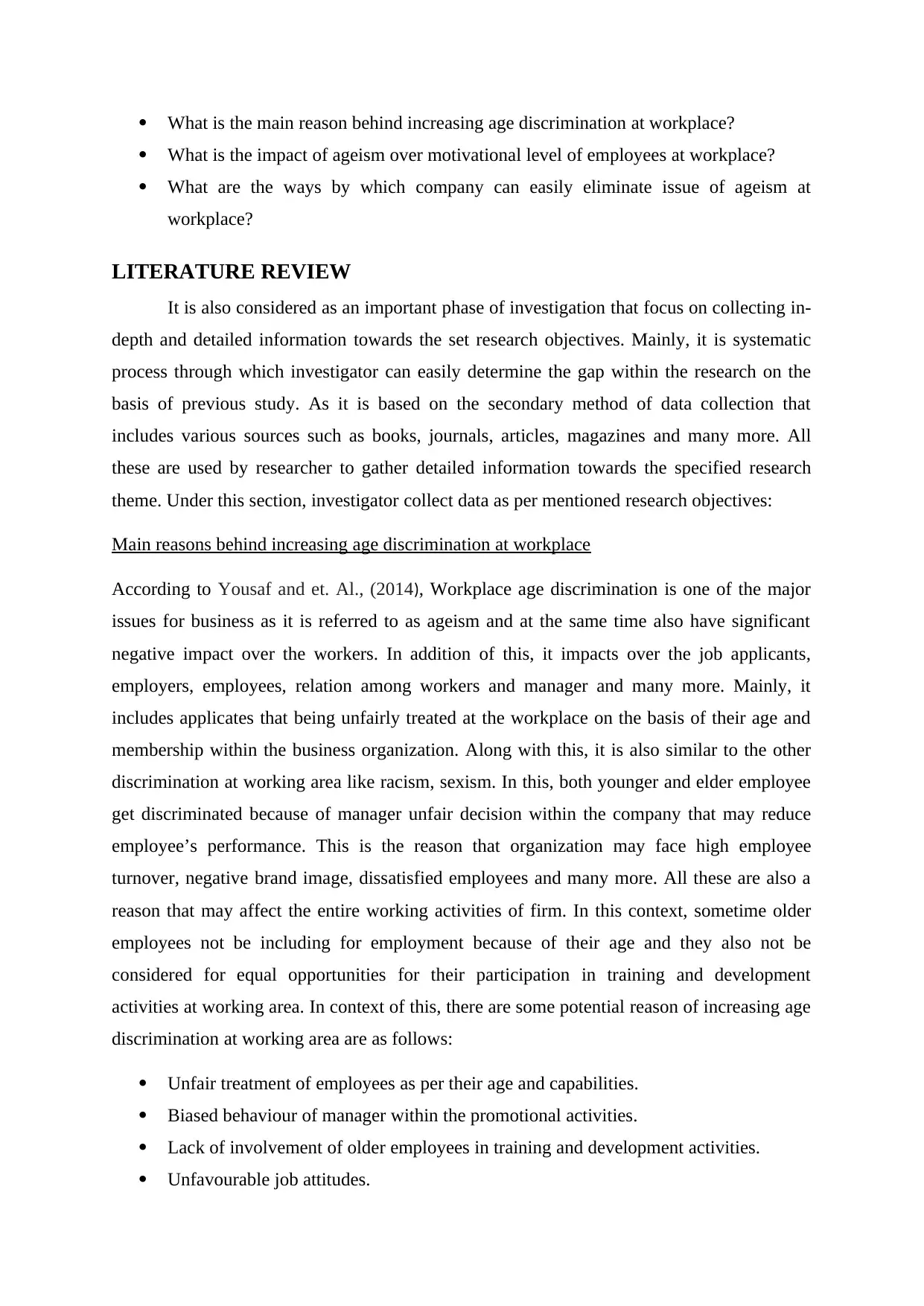
What is the main reason behind increasing age discrimination at workplace?
What is the impact of ageism over motivational level of employees at workplace?
What are the ways by which company can easily eliminate issue of ageism at
workplace?
LITERATURE REVIEW
It is also considered as an important phase of investigation that focus on collecting in-
depth and detailed information towards the set research objectives. Mainly, it is systematic
process through which investigator can easily determine the gap within the research on the
basis of previous study. As it is based on the secondary method of data collection that
includes various sources such as books, journals, articles, magazines and many more. All
these are used by researcher to gather detailed information towards the specified research
theme. Under this section, investigator collect data as per mentioned research objectives:
Main reasons behind increasing age discrimination at workplace
According to Yousaf and et. Al., (2014), Workplace age discrimination is one of the major
issues for business as it is referred to as ageism and at the same time also have significant
negative impact over the workers. In addition of this, it impacts over the job applicants,
employers, employees, relation among workers and manager and many more. Mainly, it
includes applicates that being unfairly treated at the workplace on the basis of their age and
membership within the business organization. Along with this, it is also similar to the other
discrimination at working area like racism, sexism. In this, both younger and elder employee
get discriminated because of manager unfair decision within the company that may reduce
employee’s performance. This is the reason that organization may face high employee
turnover, negative brand image, dissatisfied employees and many more. All these are also a
reason that may affect the entire working activities of firm. In this context, sometime older
employees not be including for employment because of their age and they also not be
considered for equal opportunities for their participation in training and development
activities at working area. In context of this, there are some potential reason of increasing age
discrimination at working area are as follows:
Unfair treatment of employees as per their age and capabilities.
Biased behaviour of manager within the promotional activities.
Lack of involvement of older employees in training and development activities.
Unfavourable job attitudes.
What is the impact of ageism over motivational level of employees at workplace?
What are the ways by which company can easily eliminate issue of ageism at
workplace?
LITERATURE REVIEW
It is also considered as an important phase of investigation that focus on collecting in-
depth and detailed information towards the set research objectives. Mainly, it is systematic
process through which investigator can easily determine the gap within the research on the
basis of previous study. As it is based on the secondary method of data collection that
includes various sources such as books, journals, articles, magazines and many more. All
these are used by researcher to gather detailed information towards the specified research
theme. Under this section, investigator collect data as per mentioned research objectives:
Main reasons behind increasing age discrimination at workplace
According to Yousaf and et. Al., (2014), Workplace age discrimination is one of the major
issues for business as it is referred to as ageism and at the same time also have significant
negative impact over the workers. In addition of this, it impacts over the job applicants,
employers, employees, relation among workers and manager and many more. Mainly, it
includes applicates that being unfairly treated at the workplace on the basis of their age and
membership within the business organization. Along with this, it is also similar to the other
discrimination at working area like racism, sexism. In this, both younger and elder employee
get discriminated because of manager unfair decision within the company that may reduce
employee’s performance. This is the reason that organization may face high employee
turnover, negative brand image, dissatisfied employees and many more. All these are also a
reason that may affect the entire working activities of firm. In this context, sometime older
employees not be including for employment because of their age and they also not be
considered for equal opportunities for their participation in training and development
activities at working area. In context of this, there are some potential reason of increasing age
discrimination at working area are as follows:
Unfair treatment of employees as per their age and capabilities.
Biased behaviour of manager within the promotional activities.
Lack of involvement of older employees in training and development activities.
Unfavourable job attitudes.
Paraphrase This Document
Need a fresh take? Get an instant paraphrase of this document with our AI Paraphraser
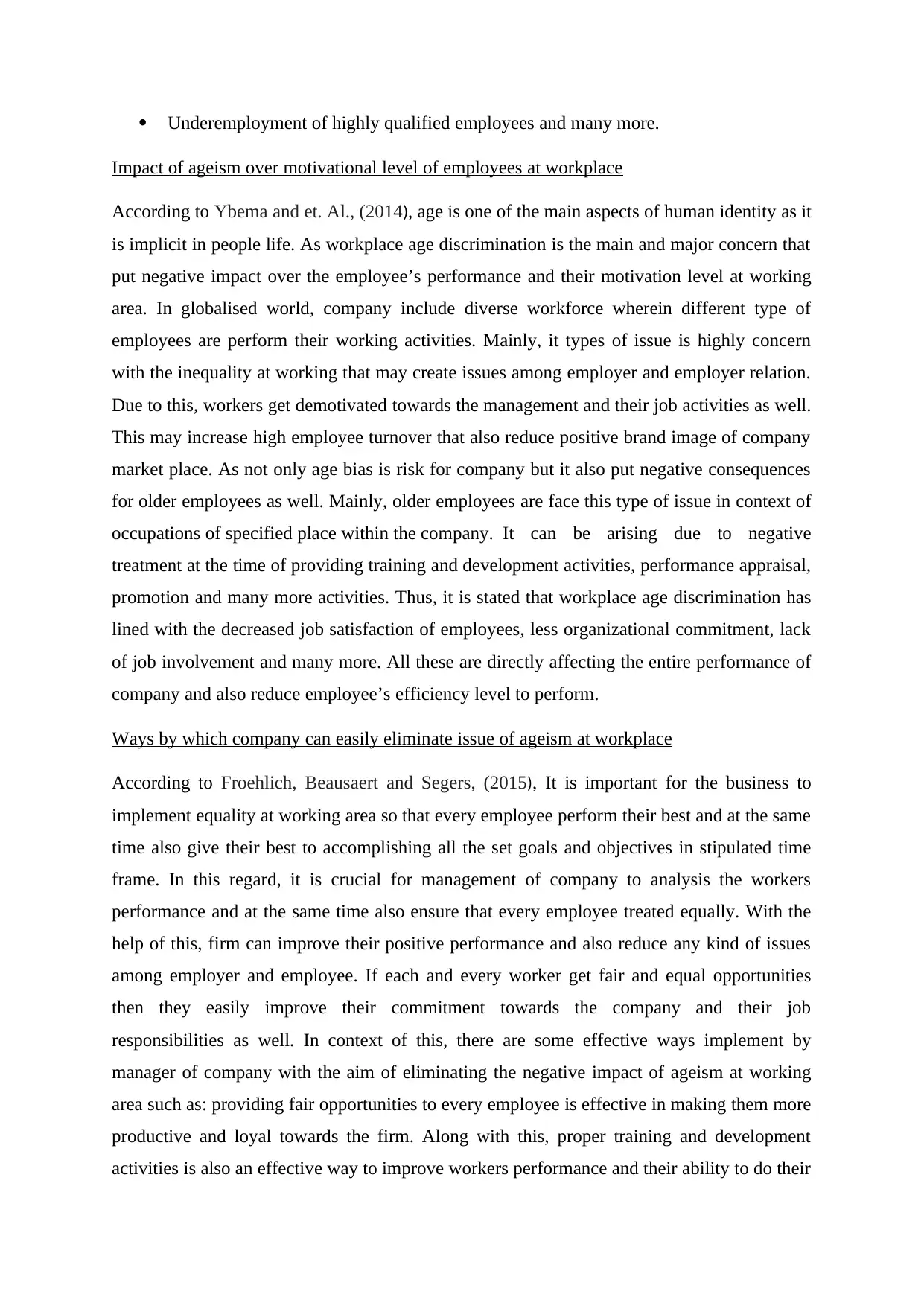
Underemployment of highly qualified employees and many more.
Impact of ageism over motivational level of employees at workplace
According to Ybema and et. Al., (2014), age is one of the main aspects of human identity as it
is implicit in people life. As workplace age discrimination is the main and major concern that
put negative impact over the employee’s performance and their motivation level at working
area. In globalised world, company include diverse workforce wherein different type of
employees are perform their working activities. Mainly, it types of issue is highly concern
with the inequality at working that may create issues among employer and employer relation.
Due to this, workers get demotivated towards the management and their job activities as well.
This may increase high employee turnover that also reduce positive brand image of company
market place. As not only age bias is risk for company but it also put negative consequences
for older employees as well. Mainly, older employees are face this type of issue in context of
occupations of specified place within the company. It can be arising due to negative
treatment at the time of providing training and development activities, performance appraisal,
promotion and many more activities. Thus, it is stated that workplace age discrimination has
lined with the decreased job satisfaction of employees, less organizational commitment, lack
of job involvement and many more. All these are directly affecting the entire performance of
company and also reduce employee’s efficiency level to perform.
Ways by which company can easily eliminate issue of ageism at workplace
According to Froehlich, Beausaert and Segers, (2015), It is important for the business to
implement equality at working area so that every employee perform their best and at the same
time also give their best to accomplishing all the set goals and objectives in stipulated time
frame. In this regard, it is crucial for management of company to analysis the workers
performance and at the same time also ensure that every employee treated equally. With the
help of this, firm can improve their positive performance and also reduce any kind of issues
among employer and employee. If each and every worker get fair and equal opportunities
then they easily improve their commitment towards the company and their job
responsibilities as well. In context of this, there are some effective ways implement by
manager of company with the aim of eliminating the negative impact of ageism at working
area such as: providing fair opportunities to every employee is effective in making them more
productive and loyal towards the firm. Along with this, proper training and development
activities is also an effective way to improve workers performance and their ability to do their
Impact of ageism over motivational level of employees at workplace
According to Ybema and et. Al., (2014), age is one of the main aspects of human identity as it
is implicit in people life. As workplace age discrimination is the main and major concern that
put negative impact over the employee’s performance and their motivation level at working
area. In globalised world, company include diverse workforce wherein different type of
employees are perform their working activities. Mainly, it types of issue is highly concern
with the inequality at working that may create issues among employer and employer relation.
Due to this, workers get demotivated towards the management and their job activities as well.
This may increase high employee turnover that also reduce positive brand image of company
market place. As not only age bias is risk for company but it also put negative consequences
for older employees as well. Mainly, older employees are face this type of issue in context of
occupations of specified place within the company. It can be arising due to negative
treatment at the time of providing training and development activities, performance appraisal,
promotion and many more activities. Thus, it is stated that workplace age discrimination has
lined with the decreased job satisfaction of employees, less organizational commitment, lack
of job involvement and many more. All these are directly affecting the entire performance of
company and also reduce employee’s efficiency level to perform.
Ways by which company can easily eliminate issue of ageism at workplace
According to Froehlich, Beausaert and Segers, (2015), It is important for the business to
implement equality at working area so that every employee perform their best and at the same
time also give their best to accomplishing all the set goals and objectives in stipulated time
frame. In this regard, it is crucial for management of company to analysis the workers
performance and at the same time also ensure that every employee treated equally. With the
help of this, firm can improve their positive performance and also reduce any kind of issues
among employer and employee. If each and every worker get fair and equal opportunities
then they easily improve their commitment towards the company and their job
responsibilities as well. In context of this, there are some effective ways implement by
manager of company with the aim of eliminating the negative impact of ageism at working
area such as: providing fair opportunities to every employee is effective in making them more
productive and loyal towards the firm. Along with this, proper training and development
activities is also an effective way to improve workers performance and their ability to do their
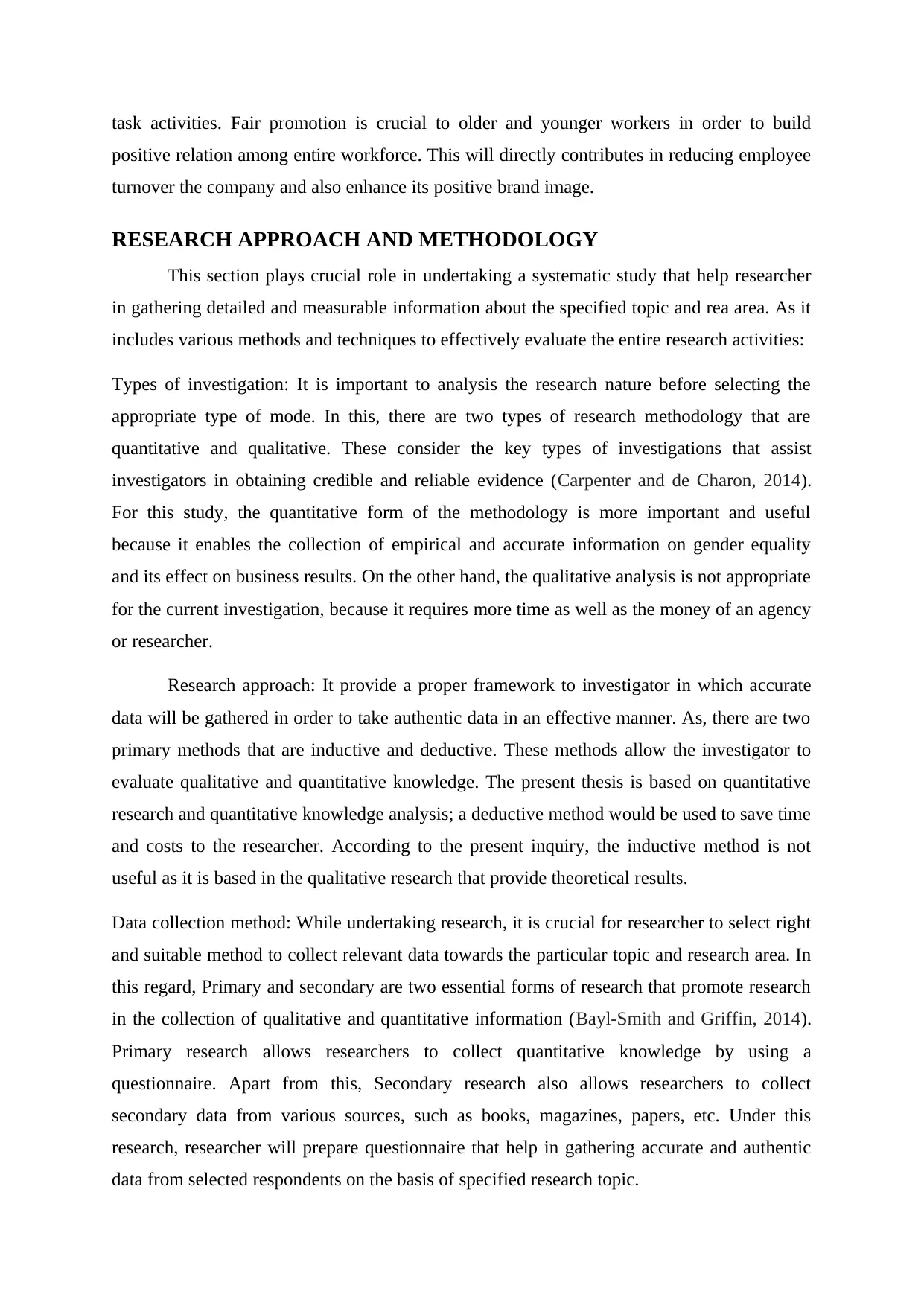
task activities. Fair promotion is crucial to older and younger workers in order to build
positive relation among entire workforce. This will directly contributes in reducing employee
turnover the company and also enhance its positive brand image.
RESEARCH APPROACH AND METHODOLOGY
This section plays crucial role in undertaking a systematic study that help researcher
in gathering detailed and measurable information about the specified topic and rea area. As it
includes various methods and techniques to effectively evaluate the entire research activities:
Types of investigation: It is important to analysis the research nature before selecting the
appropriate type of mode. In this, there are two types of research methodology that are
quantitative and qualitative. These consider the key types of investigations that assist
investigators in obtaining credible and reliable evidence (Carpenter and de Charon, 2014).
For this study, the quantitative form of the methodology is more important and useful
because it enables the collection of empirical and accurate information on gender equality
and its effect on business results. On the other hand, the qualitative analysis is not appropriate
for the current investigation, because it requires more time as well as the money of an agency
or researcher.
Research approach: It provide a proper framework to investigator in which accurate
data will be gathered in order to take authentic data in an effective manner. As, there are two
primary methods that are inductive and deductive. These methods allow the investigator to
evaluate qualitative and quantitative knowledge. The present thesis is based on quantitative
research and quantitative knowledge analysis; a deductive method would be used to save time
and costs to the researcher. According to the present inquiry, the inductive method is not
useful as it is based in the qualitative research that provide theoretical results.
Data collection method: While undertaking research, it is crucial for researcher to select right
and suitable method to collect relevant data towards the particular topic and research area. In
this regard, Primary and secondary are two essential forms of research that promote research
in the collection of qualitative and quantitative information (Bayl‐Smith and Griffin, 2014).
Primary research allows researchers to collect quantitative knowledge by using a
questionnaire. Apart from this, Secondary research also allows researchers to collect
secondary data from various sources, such as books, magazines, papers, etc. Under this
research, researcher will prepare questionnaire that help in gathering accurate and authentic
data from selected respondents on the basis of specified research topic.
positive relation among entire workforce. This will directly contributes in reducing employee
turnover the company and also enhance its positive brand image.
RESEARCH APPROACH AND METHODOLOGY
This section plays crucial role in undertaking a systematic study that help researcher
in gathering detailed and measurable information about the specified topic and rea area. As it
includes various methods and techniques to effectively evaluate the entire research activities:
Types of investigation: It is important to analysis the research nature before selecting the
appropriate type of mode. In this, there are two types of research methodology that are
quantitative and qualitative. These consider the key types of investigations that assist
investigators in obtaining credible and reliable evidence (Carpenter and de Charon, 2014).
For this study, the quantitative form of the methodology is more important and useful
because it enables the collection of empirical and accurate information on gender equality
and its effect on business results. On the other hand, the qualitative analysis is not appropriate
for the current investigation, because it requires more time as well as the money of an agency
or researcher.
Research approach: It provide a proper framework to investigator in which accurate
data will be gathered in order to take authentic data in an effective manner. As, there are two
primary methods that are inductive and deductive. These methods allow the investigator to
evaluate qualitative and quantitative knowledge. The present thesis is based on quantitative
research and quantitative knowledge analysis; a deductive method would be used to save time
and costs to the researcher. According to the present inquiry, the inductive method is not
useful as it is based in the qualitative research that provide theoretical results.
Data collection method: While undertaking research, it is crucial for researcher to select right
and suitable method to collect relevant data towards the particular topic and research area. In
this regard, Primary and secondary are two essential forms of research that promote research
in the collection of qualitative and quantitative information (Bayl‐Smith and Griffin, 2014).
Primary research allows researchers to collect quantitative knowledge by using a
questionnaire. Apart from this, Secondary research also allows researchers to collect
secondary data from various sources, such as books, magazines, papers, etc. Under this
research, researcher will prepare questionnaire that help in gathering accurate and authentic
data from selected respondents on the basis of specified research topic.
⊘ This is a preview!⊘
Do you want full access?
Subscribe today to unlock all pages.

Trusted by 1+ million students worldwide
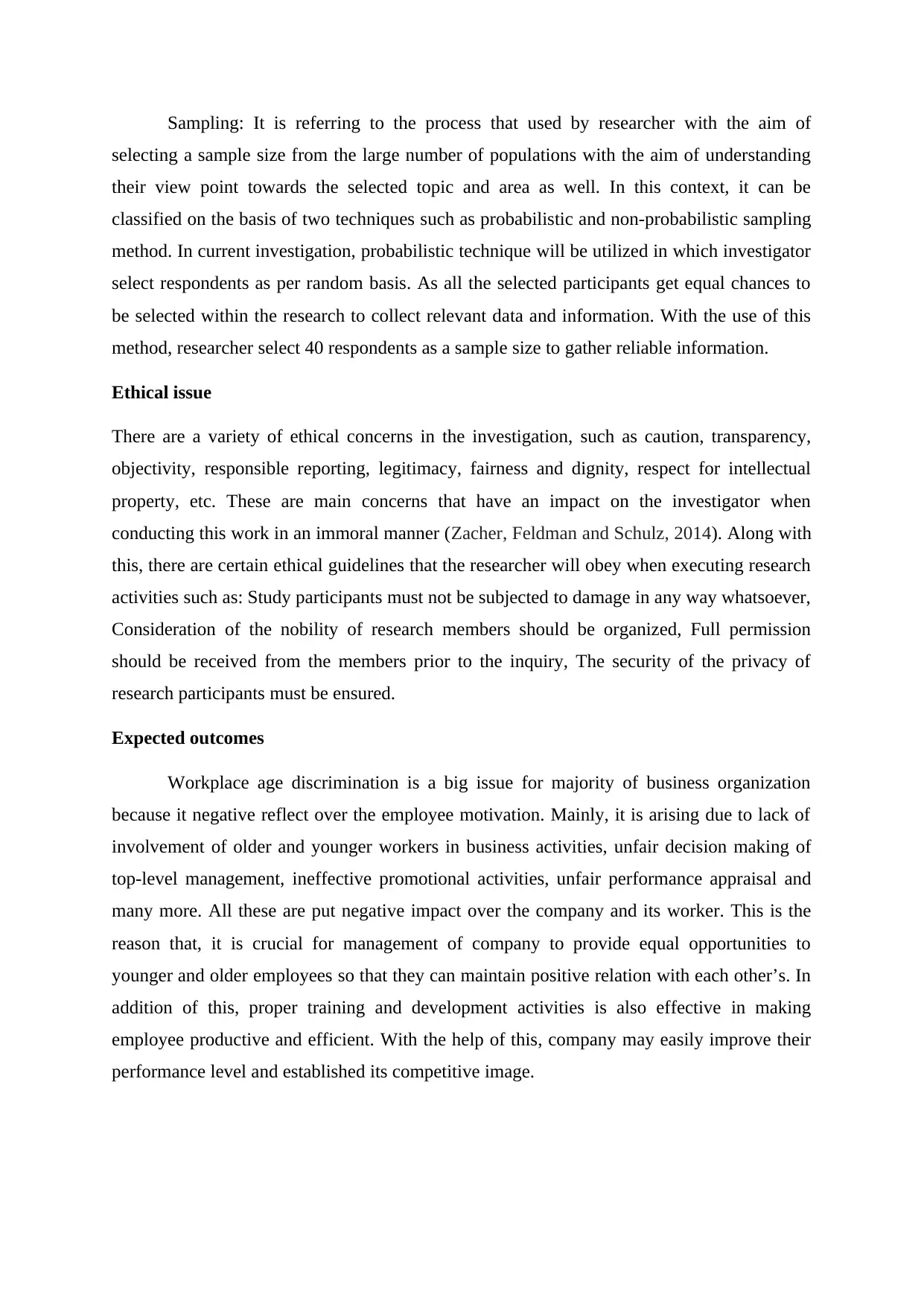
Sampling: It is referring to the process that used by researcher with the aim of
selecting a sample size from the large number of populations with the aim of understanding
their view point towards the selected topic and area as well. In this context, it can be
classified on the basis of two techniques such as probabilistic and non-probabilistic sampling
method. In current investigation, probabilistic technique will be utilized in which investigator
select respondents as per random basis. As all the selected participants get equal chances to
be selected within the research to collect relevant data and information. With the use of this
method, researcher select 40 respondents as a sample size to gather reliable information.
Ethical issue
There are a variety of ethical concerns in the investigation, such as caution, transparency,
objectivity, responsible reporting, legitimacy, fairness and dignity, respect for intellectual
property, etc. These are main concerns that have an impact on the investigator when
conducting this work in an immoral manner (Zacher, Feldman and Schulz, 2014). Along with
this, there are certain ethical guidelines that the researcher will obey when executing research
activities such as: Study participants must not be subjected to damage in any way whatsoever,
Consideration of the nobility of research members should be organized, Full permission
should be received from the members prior to the inquiry, The security of the privacy of
research participants must be ensured.
Expected outcomes
Workplace age discrimination is a big issue for majority of business organization
because it negative reflect over the employee motivation. Mainly, it is arising due to lack of
involvement of older and younger workers in business activities, unfair decision making of
top-level management, ineffective promotional activities, unfair performance appraisal and
many more. All these are put negative impact over the company and its worker. This is the
reason that, it is crucial for management of company to provide equal opportunities to
younger and older employees so that they can maintain positive relation with each other’s. In
addition of this, proper training and development activities is also effective in making
employee productive and efficient. With the help of this, company may easily improve their
performance level and established its competitive image.
selecting a sample size from the large number of populations with the aim of understanding
their view point towards the selected topic and area as well. In this context, it can be
classified on the basis of two techniques such as probabilistic and non-probabilistic sampling
method. In current investigation, probabilistic technique will be utilized in which investigator
select respondents as per random basis. As all the selected participants get equal chances to
be selected within the research to collect relevant data and information. With the use of this
method, researcher select 40 respondents as a sample size to gather reliable information.
Ethical issue
There are a variety of ethical concerns in the investigation, such as caution, transparency,
objectivity, responsible reporting, legitimacy, fairness and dignity, respect for intellectual
property, etc. These are main concerns that have an impact on the investigator when
conducting this work in an immoral manner (Zacher, Feldman and Schulz, 2014). Along with
this, there are certain ethical guidelines that the researcher will obey when executing research
activities such as: Study participants must not be subjected to damage in any way whatsoever,
Consideration of the nobility of research members should be organized, Full permission
should be received from the members prior to the inquiry, The security of the privacy of
research participants must be ensured.
Expected outcomes
Workplace age discrimination is a big issue for majority of business organization
because it negative reflect over the employee motivation. Mainly, it is arising due to lack of
involvement of older and younger workers in business activities, unfair decision making of
top-level management, ineffective promotional activities, unfair performance appraisal and
many more. All these are put negative impact over the company and its worker. This is the
reason that, it is crucial for management of company to provide equal opportunities to
younger and older employees so that they can maintain positive relation with each other’s. In
addition of this, proper training and development activities is also effective in making
employee productive and efficient. With the help of this, company may easily improve their
performance level and established its competitive image.
Paraphrase This Document
Need a fresh take? Get an instant paraphrase of this document with our AI Paraphraser
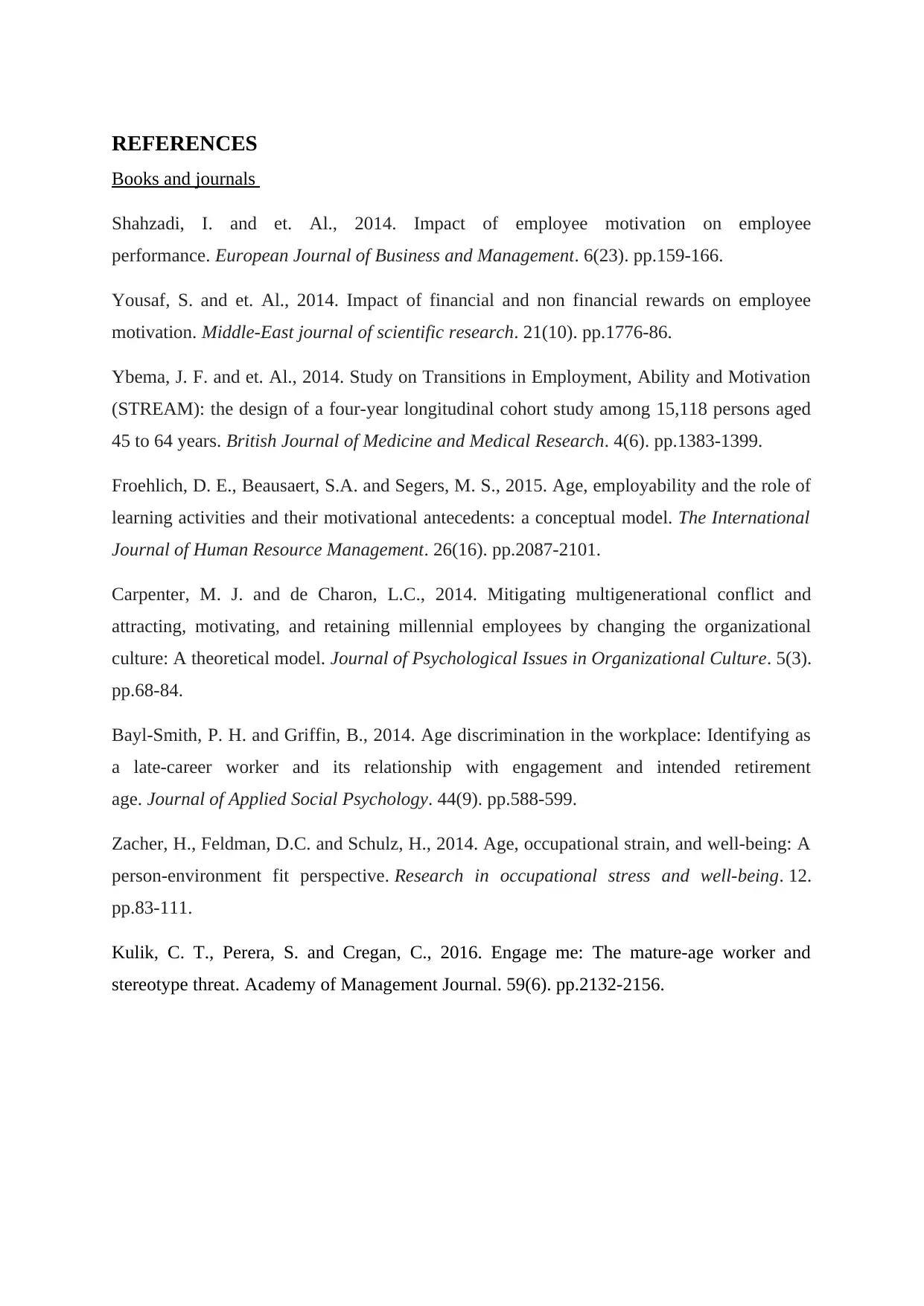
REFERENCES
Books and journals
Shahzadi, I. and et. Al., 2014. Impact of employee motivation on employee
performance. European Journal of Business and Management. 6(23). pp.159-166.
Yousaf, S. and et. Al., 2014. Impact of financial and non financial rewards on employee
motivation. Middle-East journal of scientific research. 21(10). pp.1776-86.
Ybema, J. F. and et. Al., 2014. Study on Transitions in Employment, Ability and Motivation
(STREAM): the design of a four-year longitudinal cohort study among 15,118 persons aged
45 to 64 years. British Journal of Medicine and Medical Research. 4(6). pp.1383-1399.
Froehlich, D. E., Beausaert, S.A. and Segers, M. S., 2015. Age, employability and the role of
learning activities and their motivational antecedents: a conceptual model. The International
Journal of Human Resource Management. 26(16). pp.2087-2101.
Carpenter, M. J. and de Charon, L.C., 2014. Mitigating multigenerational conflict and
attracting, motivating, and retaining millennial employees by changing the organizational
culture: A theoretical model. Journal of Psychological Issues in Organizational Culture. 5(3).
pp.68-84.
Bayl‐Smith, P. H. and Griffin, B., 2014. Age discrimination in the workplace: Identifying as
a late‐career worker and its relationship with engagement and intended retirement
age. Journal of Applied Social Psychology. 44(9). pp.588-599.
Zacher, H., Feldman, D.C. and Schulz, H., 2014. Age, occupational strain, and well-being: A
person-environment fit perspective. Research in occupational stress and well-being. 12.
pp.83-111.
Kulik, C. T., Perera, S. and Cregan, C., 2016. Engage me: The mature-age worker and
stereotype threat. Academy of Management Journal. 59(6). pp.2132-2156.
Books and journals
Shahzadi, I. and et. Al., 2014. Impact of employee motivation on employee
performance. European Journal of Business and Management. 6(23). pp.159-166.
Yousaf, S. and et. Al., 2014. Impact of financial and non financial rewards on employee
motivation. Middle-East journal of scientific research. 21(10). pp.1776-86.
Ybema, J. F. and et. Al., 2014. Study on Transitions in Employment, Ability and Motivation
(STREAM): the design of a four-year longitudinal cohort study among 15,118 persons aged
45 to 64 years. British Journal of Medicine and Medical Research. 4(6). pp.1383-1399.
Froehlich, D. E., Beausaert, S.A. and Segers, M. S., 2015. Age, employability and the role of
learning activities and their motivational antecedents: a conceptual model. The International
Journal of Human Resource Management. 26(16). pp.2087-2101.
Carpenter, M. J. and de Charon, L.C., 2014. Mitigating multigenerational conflict and
attracting, motivating, and retaining millennial employees by changing the organizational
culture: A theoretical model. Journal of Psychological Issues in Organizational Culture. 5(3).
pp.68-84.
Bayl‐Smith, P. H. and Griffin, B., 2014. Age discrimination in the workplace: Identifying as
a late‐career worker and its relationship with engagement and intended retirement
age. Journal of Applied Social Psychology. 44(9). pp.588-599.
Zacher, H., Feldman, D.C. and Schulz, H., 2014. Age, occupational strain, and well-being: A
person-environment fit perspective. Research in occupational stress and well-being. 12.
pp.83-111.
Kulik, C. T., Perera, S. and Cregan, C., 2016. Engage me: The mature-age worker and
stereotype threat. Academy of Management Journal. 59(6). pp.2132-2156.
1 out of 8
Related Documents
Your All-in-One AI-Powered Toolkit for Academic Success.
+13062052269
info@desklib.com
Available 24*7 on WhatsApp / Email
![[object Object]](/_next/static/media/star-bottom.7253800d.svg)
Unlock your academic potential
Copyright © 2020–2025 A2Z Services. All Rights Reserved. Developed and managed by ZUCOL.





